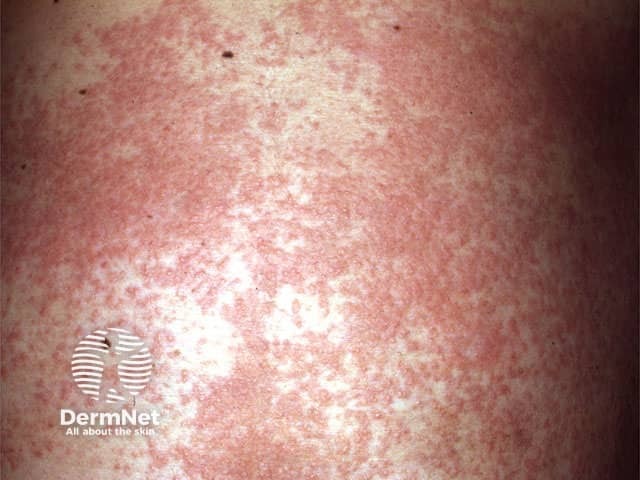Main menu
Common skin conditions

NEWS
Join DermNet PRO
Read more
Quick links
Disseminated secondary eczema — extra information
Disseminated secondary eczema
Author: Vanessa Ngan, Staff Writer, 2003. Updated by A/Prof Amanda Oakley, Dermatologist, Hamilton, New Zealand, July 2014.
Introduction Causes Demographics Clinical features Diagnosis Treatment
What is disseminated secondary eczema?
Disseminated secondary eczema is an acute, generalised dermatitis that arises in response to a localised inflammatory skin disease.
It is also called an id reaction, autosensitisation dermatitis, and autoeczematisation.


What causes disseminated secondary eczema?
The cause of disseminated secondary eczema is unknown. Theories suggest it is an immune response to a component of the skin and/or to circulating infectious agents or cytokines.
Who gets disseminated secondary eczema?
Disseminated secondary eczema can occur in children and adults, but is typically diagnosed in older people with a neglected primary rash on the lower leg.
The common types of eczema/dermatitis that precede disseminated secondary eczema—an eczematid—are:
- Chronic venous eczema
- Acute contact dermatitis
- Acute or chronic discoid eczema.
Infections associated with disseminated secondary eczema include:
- Fungal skin infection eg, inflammatory tinea pedis or kerion — dermatophytide
- Bacterial skin infection eg, wound infection or thermal burn — bacterid
- Viral infection eg, molluscum contagiosum
- Arthropod infestation eg, scabies or lice — pediculid.
What are the clinical features of disseminated secondary eczema?
Disseminated secondary eczema presents as an acute, symmetrical, generalised acute eczema. It tends to be extremely itchy, disturbing sleep.
- Forearms, lower legs, thighs, and trunk are commonly affected.
- Appearance varies and includes blisters, bumps, crusted plaques (discoid eczema), follicular papules, morbilliform eruption, targetoid lesions, and vesicular hand dermatitis.
- Occasionally, the patient may feel unwell with fever and loss of appetite.
Non-eczematous id reactions include erythema nodosum, acute febrile neutrophilic dermatosis, guttate psoriasis, and blistering skin conditions.
How is disseminated secondary eczema diagnosed?
The clinical features of disseminated secondary eczema are characteristic. Finding the cause depends on taking a careful history of the initial site of a skin problem. Sometimes the patient does not associate a chronic minor rash with their current widespread and symptomatic eruption.
Additional investigations that may be considered include:
- Trichoscopy (dermoscopy of the hair) for nits (head lice) and burrows for scabies mites
- Swabs of crusted areas or pustules for bacteriology
- Scrapings of scaly annular or hairless plaques for mycology
- Skin biopsy of the primary lesion and secondary rash
- histology is a spongiotic dermatitis
- Blood count in an unwell patient
- Referral for patch tests, if there is suspicion of contact allergy
- Patch testing should not be undertaken during the acute phase of disseminated secondary eczema but can be planned in several months when it has settled.
What is the treatment for disseminated secondary eczema?
The primary rash needs to be treated vigorously. This may require systemic therapy, such as antibiotics for a bacterid or oral antifungal for a confirmed dermatophytide.
The secondary eczema is often extensive and highly symptomatic. Treatment may entail:
- Referral for specialist assessment and treatment, including admission to hospital
- Wet wraps or dressings for weepy eczematous plaques
- Potassium permanganate 1:10,000 soaks for localised oozing, infected areas
- Potent topical steroid creams for 1–3 weeks
- Systemic corticosteroid, such as prednisone or prednisolone for several weeks
- Oral sedating antihistamine at night.
On DermNet
Other websites
- Id Reaction (Autoeczematization) – Medscape Reference
